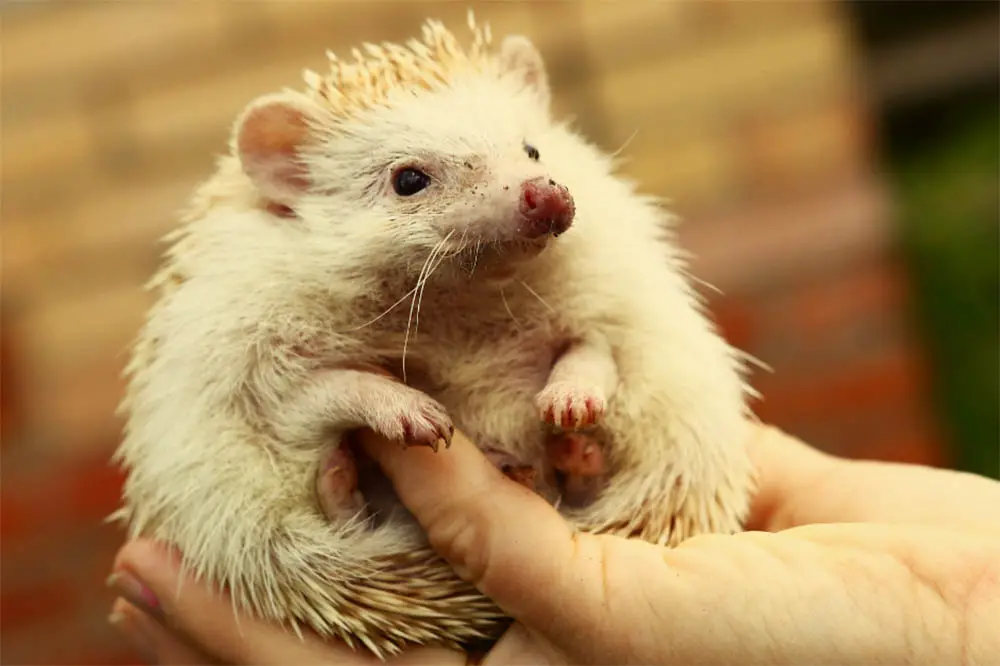Your hedgehog is likely to experience a mite infestation at some point in its life. Bites from these parasites can be painful, often leading to itchiness and skin irritation.
Your hedgehog may get mites from another infested hedgehog that they have come into contact with when in the care of the breeder or at the pet store.

Knowing the signs of mites and how to treat them is crucial for the health of your hedgehog.
If left untreated, an infestation can escalate to a more severe problem. We have covered everything that you need to know about hedgehog mites in our guide below.
What are mites?
A mite is a small arachnid that is typically red or black. Their bites can irritate a hedgehog’s skin and can also affect their quills and hair. You may be able to see the mites on their skin, however, some species are so small that they will be much more difficult to identify.
If the mites cannot be seen, there will likely be visible signs of damage. They can affect any hedgehog regardless of its sex and age.
Signs that your hedgehog has mites
Now that you know what mites are, you will need to make yourself aware of the signs as you will then be able to react accordingly to the problem.
During the early stages of an infestation, the signs may not be very noticeable, if you can’t see the mites, there are several other things that you can look out for.
One of the most common symptoms is irritation and itchiness which can create patches of dry skin. Of course, you should expect your hedgehog to itch from time to time, however, if it becomes more intense this is a sign of a problem.
This excessive itching is likely to result in patches of redness or flakiness. You may also notice that your hedgehog has started to lose a lot of its quills, particularly around its back.

Quill loss isn’t an abnormal occurrence and you should expect this to happen a few times throughout your hedgehog’s life. The main difference between normal quilling and quill loss caused by mites is that the aforementioned tends to be more evenly distributed rather than concentrated.
Mites can make your hedgehog feel particularly uncomfortable and because of this, you may notice a change in its behavior. For example, there is a chance that your hedgehog is irritable and grumpier than normal.
It may also appear disinterested in its favorite activities. Moreover, if you try to interact with your hedgehog and it goes to bite you in retaliation you may have touched a sensitive spot.
It is worth noting that this can be a sign of another illness. As such, it is important to respond to any changes in your hedgehog’s behavior and mood.
Some hedgehogs that are suffering from a mite infestation may lose their appetite and as a result, may begin to lose weight.
What causes mites in hedgehogs?
There are several ways in which your hedgehog may contract mites. A stressed hedgehog is going to be more susceptible to catching mites than others. Another common cause of mites is infested bedding and cage accessories.
This is a particularly prominent issue with hedgehogs that are purchased from pet stores as their cages are typically located near other animals who may have mites. If they haven’t come from the bedding, they may have come from their food and found their way into their cage.
If you own other animals alongside your hedgehog they may be carriers of mites. Stroking them and then handling your hedgehog is going to increase the risk of transmitting them from one animal to the other.
Even if you keep all of your animals completely separated, these mites are more than likely to find their way to your hedgehog. Another cause closely linked to this is interacting with a different hedgehog before touching your own.
The mites may have clung to your clothing and because of this, your hedgehog is at more risk of contracting them.
How to prevent a mite infestation
A mite infestation is easily preventable. It is simply a matter of being cautious before handling your hedgehog. First, you must ensure that you clean your hands thoroughly after handling any other hedgehog or pet.
If you already have a hedgehog and are looking to introduce another, you must quarantine any new additions for a short period of time. This will allow you to monitor them to check that they are not infested.
When you are confident that your new hedgehog is not carrying mites, you can then introduce them to the enclosure with the others.
You must also make sure that you keep on top of your hedgehog’s cleanliness by giving it regular baths.
Of course, bathing your hedgehog is important for its general health but it will also be particularly effective in preventing a mite infestation.
Another important step is to freeze any new hedgehog food or bedding before adding it to your pet’s enclosure. This will help to kill any mites and eggs that have wormed their way into the food or bedding.
Treating mites
Unfortunately, there isn’t a treatment available that is specifically intended for hedgehogs, however, there are mite treatments for cats and dogs that can be used on hedgehogs.
You should not use any type of treatment on your hedgehog without seeking approval from a vet beforehand because some can be toxic to its health.
You should not use any collars or sprays because they can be fatal to your hedgehog. It is also important to treat the environment that your hedgehog occupies, including their bedding and food bowls.
If the bedding cannot be washed you should dispose of it and replace it with fresh bedding that has not been affected by mites.
Final Thoughts
Many signs will indicate whether your hedgehog has mites and there are also several ways in which you can treat and prevent a future infestation.









